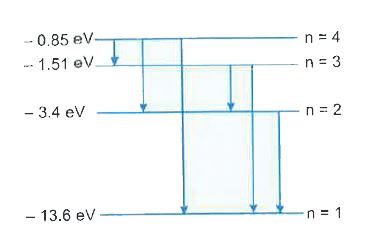The energy levels of a hypothetical atom are shown in Fig.12.13. Which of the shown transitions will result in the emission of a photon of wavelength 275 nm ?
Which of these transitions correspond to emission of radiation of (i) maximum and (ii) minimum wavelength ?
If a light photon of wavelenght λ=275nm=2.75×10−7 m is emitted , then energy of photon
E=hcλJ=hcλ×1.60×10−19eV
=6.63×10−34×3×1082.75×10−7×1.60×10−19eV=4.5eV

From the energy level diagram given, we find that a light photon of energy 4.5 eV can be emitted only when electron transition takes from 0 eV energy level to -4.5 eV energy level because then E1−E2=0−(−4.5)=+4.5eV.
Hence, transition B will result in the emission of a photon of wavelength 275 nm.
(i) For emission of radiation of maximum wavelength the energy of emitted photon should be minimum. Obviously, the transition A corresponds to emission of maximum wavelength radiation because energy in this transition [0 eV -(-2 eV) = 2 eV] is minimum.
(ii) For emission of radiation of minimum wavelength the energy of emitted photon should be maximum. Obviously, the transition D corresponds to emission of minimum wavelength radiation because energy in this transition [(-2 eV)-(-10 eV) = 8 eV] is maximum.
Topper's Solved these Questions
- ATOMSBOOK - U-LIKE SERIESCHAPTER - ATOMSEXERCISE - LONG ANSWER QUESTIONS - II
4 Videos
- ATOMSBOOK - U-LIKE SERIESCHAPTER - ATOMSEXERCISE - SELF ASSESSMENT TEST (SECTION A( MULTIPLE CHOICE QUESTIONS))
5 Videos
- ATOMSBOOK - U-LIKE SERIESCHAPTER - ATOMSEXERCISE - SHORT ANSWER QUESTIONS
30 Videos
- ALTERNATING CURRENT BOOK - U-LIKE SERIESCHAPTER - ALTERNATING CURRENT EXERCISE - SELF ASSESSMENT TEST (SECTION -C)
2 Videos
- CBSE EXAMINATION PAPER 2020 BOOK - U-LIKE SERIESCHAPTER - CBSE EXAMINATION PAPER 2020 EXERCISE - SECTION D
12 Videos
Similar Questions
The energy levels of a hypothetical aton are shown below. Which of the shown transitions will result in the emmission of a photon of wavelength 275 nm?
Which of these transitions correspond to emission of radiation of (i) maximum and (ii) minimum wavelength?

View SolutionThe energy levels of a hypothetical aton are shown below. Which of the shown transitions will result in the emmission of a photon of wavelength 275 nm?
Which of these transitions correspond to emission of radiation of (i) maximum and (ii) minimum wavelength?

View Solution
Knowledge Check
Which of the following transitions will have highest emission wavelength ?
An=2 to n=1Bn=1 to n=2Cn=2 to n=5Dn=5 to n=2
The energy levels of an atom are as shown in figure . Which one of those transition will result in the emission of a photon of wavelength 275nm?

View SolutionThe energy levels of an atom are as shown in figure . Which one of those transition will result in the emission of a photon of wavelength 275nm?

View SolutionThe energy levels of an atom are shown in fig. Which transition corresponds to emission of radiation of (i) maximum wavelength (ii) minimum wavelength?

View SolutionFig. shows energy level diagram of hydrogen atom. Find out the transition which results in the emission of a photon of wavelength 496 nm. Which transition corresponds to emission of radiation of maximum wavelength? Justify your answer.

View SolutionThe energy levels of an atom of element X are shown in Fig. 20.2. Which one of the level transitions will result in the emission of photons of wavelength 620 nm ? Support your answer with mathematical calculations.

View SolutionThe fig.12.15 showes energy level diagram of hydrogen atom .
(a) Find the transition which results in the emission of a photon of wavelenght 496 nm .
(b) Which transition corresponds to the emission of radiation of maximum wavelenght ? Justify your answer .

View SolutionThe Fig 12.17 shows energy level diagram of hydrogen atom.
(a) Find the transition which results in the emission of a photon of wavelenght 496 nm .
(b) Which transition corresponds to the emission of radiation of maximum wavelenght ? Justify your answer .

View Solution
